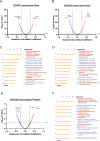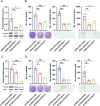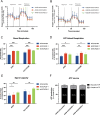OCIAD2 Promotes Cancer Progression via Metabolic Reprogramming in Lung Adenocarcinoma
- PMID: 40690206
- PMCID: PMC12323000
- DOI: 10.1021/acs.jproteome.5c00273
OCIAD2 Promotes Cancer Progression via Metabolic Reprogramming in Lung Adenocarcinoma
Abstract
Given the limited proteomic insights and high incidence of lung adenocarcinoma, further investigation of uncharacterized proteins in cancer progression remains crucial. In this study, a poorly characterized protein, OCIA domain-containing 2 (OCIAD2), encoded by chromosome 4 was identified as being upregulated in lung adenocarcinoma from our previous proteogenomics data using the Taiwan Cancer Moonshot cohort. OCIAD2 was highly expressed in tumor tissues in 95.5% of lung adenocarcinoma patients in our cohort, with elevated expression correlating with worse survival. Functional studies revealed that the silencing of the OCIAD2 decreased cell migration, invasion, and colony-forming abilities. Gene Set Enrichment Analysis (GSEA) indicated the involvement of OCIAD2 in oxidative phosphorylation (OXPHOS). Subsequently, mitochondrial metabolic assay demonstrated that OCIAD2 impairs OXPHOS function, accompanied by a metabolic shift toward glycolysis. These findings suggest that OCIAD2 promotes cancer progression through metabolic reprogramming, highlighting the role of OCIAD2 as a potential biomarker and therapeutic target for lung adenocarcinoma.
Keywords: Chromosome-centric Human Proteome Project; Lung adenocarcinoma; Ovarian Cancer Immunoreactive Antigen Domain Containing 2; Uncharacterized protein existence level 1.
Figures





Similar articles
-
Unraveling the role of GPCR signaling in metabolic reprogramming and immune microenvironment of lung adenocarcinoma: a multi-omics study with experimental validation.Front Immunol. 2025 Jun 6;16:1606125. doi: 10.3389/fimmu.2025.1606125. eCollection 2025. Front Immunol. 2025. PMID: 40547013 Free PMC article.
-
Caveolin-1 inhibits the proliferation and invasion of lung adenocarcinoma via EGFR degradation.Sci Rep. 2025 Jul 1;15(1):21654. doi: 10.1038/s41598-025-05259-8. Sci Rep. 2025. PMID: 40594106 Free PMC article.
-
The prognostic significance and Immunomodulatory role of SCGB3A1 expression in stage I lung adenocarcinoma.BMC Med Genomics. 2025 Jul 21;18(1):119. doi: 10.1186/s12920-025-02192-7. BMC Med Genomics. 2025. PMID: 40691840 Free PMC article.
-
Circ0515 reprogramming mitochondrial succinate metabolism and promotes lung adenocarcinoma progression through regulating SDHB.Cell Death Dis. 2025 Jul 5;16(1):497. doi: 10.1038/s41419-025-07830-7. Cell Death Dis. 2025. PMID: 40617805 Free PMC article.
-
Identification of a novel therapeutic candidate, NRK, in primary cancer-associated fibroblasts of lung adenocarcinoma microenvironment.J Cancer Res Clin Oncol. 2021 Apr;147(4):1049-1064. doi: 10.1007/s00432-020-03489-z. Epub 2021 Jan 2. J Cancer Res Clin Oncol. 2021. PMID: 33387038 Free PMC article.
References
-
- Omenn G. S., Orchard S., Lane L., Lindskog C., Pineau C., Overall C. M., Budnik B., Mudge J. M., Packer N. H., Weintraub S. T.. et al. The 2024 Report on the Human Proteome from the HUPO Human Proteome Project. J. Proteome Res. 2024;23(12):5296–5311. doi: 10.1021/acs.jproteome.4c00776. - DOI - PMC - PubMed
-
- Paik Y. K., Lane L., Kawamura T., Chen Y. J., Cho J. Y., LaBaer J., Yoo J. S., Domont G., Corrales F., Omenn G. S.. et al. Launching the C-HPP neXt-CP50 Pilot Project for Functional Characterization of Identified Proteins with No Known Function. J. Proteome Res. 2018;17(12):4042–4050. doi: 10.1021/acs.jproteome.8b00383. - DOI - PMC - PubMed
-
- Zhang Y., Vaccarella S., Morgan E., Li M., Etxeberria J., Chokunonga E., Manraj S. S., Kamate B., Omonisi A., Bray F.. Global variations in lung cancer incidence by histological subtype in 2020: a population-based study. Lancet Oncol. 2023;24(11):1206–1218. doi: 10.1016/S1470-2045(23)00444-8. - DOI - PubMed
MeSH terms
Substances
LinkOut - more resources
Full Text Sources
Medical

